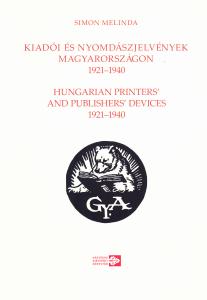
Hungarian Printers’ and Publishers’ Devices 1921–1940
Hungarian Printers’ and Publishers’ Devices 1921–1940
Written by Melinda Simon
NSZL, Budapest, 2023, 244 pages
ISBN 978 963 200 726 7
The exhaustive publication of the printers’ and publishers’ devices used in Hungary was started in 2009 with the material of the 15th–18th centuries1, followed by the 19th century in 20122 and completed with the first two decades of the 20th century in 2019.3 The ever-narrower periods of these volumes demonstrated quite spectacularly the acceleration in the growth of the number of marks. To illustrate this phenomenon, I am presenting once again the augmented diagram from the previous volume. It is evident that following the constantly low numbers of the first centuries the 19th century has brought an “explosion” of devices, and the first two decades of the 20th century has shown an even greater in-crease in their number. In comparison, the period between 1921–1940 shows almost the same number of printers’ and publishers’ marks as the previous two decades. This could apparently imply a stag-nation, but since after 1920 the geographical territory of Hungary has decreased significantly, we can establish that the rhythm of growth of the marks has not slowed down.
This also means that beginning with 1921 the printers’ and publishers’ devices used on the Hungarian territories lost due to the Treaty of Trianon cannot be integrated anymore in the collection – because the objective set at the start of this series was (and has remained) to register and to publish the marks used between the actual political borders of Hungary. During the research I have naturally registered data on the lost territories, too. I will later publish these “transborder” Hungarian printers’ and publishers’ devices in some other form.
However, the previously mentioned growth does not mean at all that the Hungarian publishing and printing industry would have gone through some unexplainable development following the First World War. The phenomenon can be explained much more with the multitude of short-lived publishers which was characteristic to this period.
This volume – as its predecessors – is divided into two distinct sections, presses and publishers. Naturally, there is some overlapping between the two parts because some of the companies of this period were sometimes interested in both activities, but the iconographic content of the designs is extremely specific to each group. These characteristics are much better recognizable divided to presses and publishers, then in a joint mechanical alphabetical order. The processed data of this volume contains 254 publishers’ marks and 246 printers’ marks, so the two types give approximately 50–50%.
The devices were often used by the companies in different sizes, because the different methods of electrotyping and zincography of the era made it possible to produce a cliché of optional size from an original drawing. Therefore – as in the previous volumes – in the catalogue we give horizontal and vertical data on all sizes, but we reproduce just the largest version in its original size.
Shopping
Our publications are available in our bookshop, or can be ordered from the Publications Department of the NSZL using the contact details below: Főigazgatói Kabinet kiadványtára, Országos Széchényi Könyvtár, 1276 Budapest P.O. box 1205., phone: 06-1-23-23-506, e-mail: kiadvanytar@oszk.hu.




